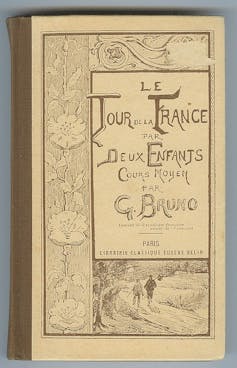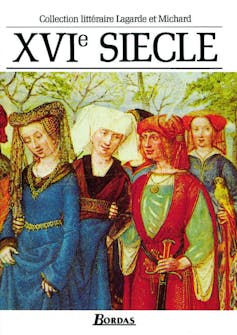From Lavisse to Bescherelle, textbooks that have marked generations of students
Lavisse, Bled, Bescherelle, Lagarde et Michard - these names are irrevocably linked to the history, conjugation, spelling and literature textbooks written by these teachers. Their works left their mark on the school history of the 19th and 20th centuries, becoming part of every student's reference toolbox.
Sylvain Wagnon, University of Montpellier

DarkWorkX/Pixabay , CC BY
What accounts for this longevity? How have these textbooks become symbols of a certain school culture? What do they tell us about the organization of the French education system and the way we teach today?
Witnesses of their time and objects of research, textbooks need to be approached holistically. A pioneer in the study of textbooks, Alain Choppin has clearly shown that the textbook is a false historical truism, covering a diversity of formats and uses. As tools for implementing curricula, as links between the institution, teachers, students and parents, textbooks are the pillars of the development of a school culture, to use André Chervel's term, based on encyclopedic academic knowledge.
Their content is sometimes contested on the grounds of bias. By their impossible neutrality, they have conveyed, then as now, gender and class stereotypes. Although their demise is often prognosticated in the face of the expansion of online resources, they are still with us, in paper or digital form. The recent period of confinement has only confirmed this state of affairs, with digital textbooks being made available free of charge, in the name of pedagogical continuity.
School novels
Ernest Lavisse (1842-1922) was one of Armand Colin's most prolific and widely published authors, with over 20 million copies sold for all levels of education. A renowned historian, he developed a "national novel" around a school history centered on France, its power and its mythologized male characters.

Jean Poussin/Wikimedia, CC BY
In the same spirit, Le tour de France par deux enfants by Augustine Fouillée, who wrote under the pseudonym G. Bruno, first published in 1877, reflects the same conception of the textbook and the model lesson: an encyclopedic narrative that enables the teacher to be the pivot of knowledge transmission, and to develop a patriotic discourse in post-1870 France and the construction of the Republic.
What are commonly referred to as "les petits Lavisse" remained the standard history textbooks until the Second World War. Today, of course, the evolution of the discipline and of teaching towards a reflection based on the study of documents make Lavisse a vestige of an ancient history. Nevertheless, these works are constantly reissued to this day as references of an ancient and nostalgic history.
French language and literature
While Ernest Lavisse, an academic, wrote for teachers and pupils based on his conception of history, Odette and Édouard Bled, primary school teachers, designed their spelling and grammar manual based on their observations in the "field". A must-have for every generation of schoolchildren since its first edition in 1946, the Bled is often associated with the "Bescherelle" verb conjugation manual.
Supported by the educational establishment, these two books are still perceived as "official", indispensable works of schooling. They nonetheless reflect a certain vision of teaching. Édouard Bled was a staunch opponent of any spelling reform, and the Bescherelle, by relying exclusively on rote learning, failed to take into account the evolution of teaching towards context and text analysis.

Bordas Editions
From 1948 onwards, André Lagarde and Laurent Michard, secondary school teachers and then general inspectors, published a series of textbooks featuring excerpts from literary reference texts, illustrations and biographies. Their first publication marked an editorial revolution. In a total of six volumes, they offer a chronological anthology of French literature.
Today, the Lagarde et Michard are more like symbols of a secondary education based on encyclopedism. On the other hand, in terms of content, the choice of certain text extracts and commentaries is open to criticism. Nevertheless, these works, which have also sold over 20 million copies, remain references for some teachers and, above all, the memory of several generations of high school students.
Exchange tool
We can therefore legitimately wonder about the longevity of these books. Is this a sign of their extraordinary capacity for renewal, or a symptom of a certain pedagogical inertia? New-education pedagogues such as Célestin Freinet in the early 20th century criticized the magisterial nature of textbooks, which prevented students from thinking independently.
Since the 1960s, textbooks are no longer just books by authors, but by teams. No single textbook now has such a monopoly, and the many publishing houses are vying with each other in their ingenuity to offer textbooks with high-quality illustrations and documents, and which take into account the evolution of teaching methods. School books account for between 12% and 18% of French publishing sales.
Secondly, the use of textbooks in the classroom is a complex issue. They are a reference, a support for the transmission of knowledge for teachers, but also an intermediary for communicating programs to parents, as the period of confinement clearly showed.
See also:
Distance learning: lessons from e-confinement
Until today, textbook use has also led to a specific school culture and form, in which the teacher and his or her transmitted knowledge are at the heart of the institution. For the time being, the digital revolution seems to be doing little to change this. Perceived as the preferred tools of apprenticeshipsBut textbooks must also be tools for understanding the changes taking place in our societies, and vectors for transforming our ways of seeing.![]()
Sylvain Wagnon, Professor of Education, Faculty of Education, University of Montpellier
This article is republished from The Conversation under a Creative Commons license. Read theoriginal article.